

Original Article - Year 2009 - Volume 24 - Issue 2
Histopathological melanoma behavior analysis fundamental for a good practice in plastic surgery
Análise do comportamento histopatológico do melanoma fundamental para uma boa prática na cirurgia plástica
ABSTRACT
Introduction: The plastic surgeon often treats patients with the most varied types of skin injuries, and, undoubtedly faces the melanoma, which consist a malignancy of skin and mucosa and represents 3% to 4% of the malignant skin neoplasias. It is the most aggressive cutaneous carcinoma. Methods: Were studied 116 diagnosed cases of melanoma at the pathology laboratory. The collected data concerning gender, age, margins, Breslow's thickness, Clark's level, mitotic index and presence or absence of regression, and ulceration were statistically analyzed and compared. Results: The patients corresponded 67.2% to women and 32.8% to men. The average age was of 56 years. There was no statistically significant difference between the genders. There was a histological predominance of the superficial diffusion type with 62.7% and nodular with 18.1%. There was no statistically significant association between: regression and BC index, sex and BC index, histological type and regression, histological type and sex, mitotic index and histological type of the tumor, angiolymphatic invasion, free or implicated margins or with either presence or absence of regression (p > 0.005). There was a statistically significant strong association between angiolymphatic invasion and BC index, histological type and BC index, histological type and angiolymphatic invasion, histological type and ulceration, and in the relationship mitotic index and BC index (p < 0.005). Conclusion: The treatment of this pathology demands a profound knowledge of its histological behavior, as based on this knowledge the initial surgical treatment is planned, enabling foreseeing the prognosis and evolution of the disease.
Keywords: Melanoma. Plastic surgery. Neoplasms. Neoplasm invasiveness. Neoplasm staging.
RESUMO
Introdução: O cirurgião plástico trata pacientes com os mais variados tipos de lesões de pele, sendo que invariavelmente se defronta com o melanoma, que constitui uma lesão maligna de pele e mucosas e representa 3% a 4% das neoplasias malignas da pele. É o carcinoma cutâneo mais agressivo. Método: Foram estudados 116 casos de melanoma diagnosticados no laboratório de patologia. Os dados obtidos em relação a gênero, idade, margens, espessura de Breslow, nível de Clark, índice mitótico e presença ou ausência de regressão, e ulceração foram cruzados e analisados estatisticamente. Resultados: No estudo, 67,2% dos pacientes correspondiam a mulheres e 32,8%, a homens. A idade média foi de 56 anos. Não houve diferença de idade estatisticamente significante entre os sexos. Houve predominância histológica do tipo difusão superficial com 62,7% e nodular com 18,1%. Não houve associação estatisticamente significante entre: regressão e índice BC, sexo e índice BC, tipo histológico e regressão, tipo histológico e sexo, índice mitótico e tipo histológico do tumor, invasão angiolinfática, margens livres ou comprometidas ou com presença ou ausência de regressão (p > 0,005). Houve forte associação estatisticamente significante entre invasão angiolinfática e índice BC, tipo histológico e índice BC, tipo histológico e invasão angiolinfática, tipo histológico e ulceração, e na relação índice mitótico e índice BC (p < 0,005). Conclusão: O tratamento desta afecção necessita de um profundo conhecimento de seu comportamento histológico, pois baseado neste conhecimento é planejado o tratamento cirúrgico inicial, sendo possível prever o prognóstico e evolução da doença.
Palavras-chave: Melanoma. Cirurgia plástica. Neoplasias. Invasividade neoplásica. Estadiamento de neoplasias.
O melanoma maligno constitui-se de uma lesão maligna de pele e mucosas, cuja incidência vem aumentando e representa 3% a 4% das neoplasias malignas da pele. É o carcinoma cutâneo mais agressivo, possuindo as mais altas taxas de morbidade e mortalidade1. Ocorre principalmente em pessoas com pele clara, com presença de nevus, podendo haver um componente genético e impacto da exposição à radiação ultravioleta (UV)2-4.
O melanoma é classificado histologicamente em quatro principais tipos: melanoma de crescimento superficial, melanoma nodular, lentigo maligno melanoma e melanoma lentiginoso acral5. A espessura do tumor mostrou-se o fator prognóstico mais importante no melanoma maligno localizado6. Para melhor classificar este fator, são utilizadas as classificações de Breslow e Clark, que são baseadas na espessura do tumor e no nível de invasão da pele, respectivamente. As duas classificações mostraram-se importantes fatores prognósticos7. Além da espessura da lesão, outros fatores têm sido relacionados com mau prognóstico. Dentre eles, estão ulceração, tipo nodular, gênero masculino, idade superior a 65 anos8 e invasão angiolinfática9,10.
O melanoma cutâneo drena para o sistema linfático e seus níveis subsequentes. O linfonodo sentinela é o primeiro linfonodo a ser atingido pela metástase, se negativo, existe alta probabilidade de que os demais linfonodos não estejam acometidos11. Uma importante mudança nos estudos de melanoma foi a adoção do mapeamento linfático pela biópsia do linfonodo sentinela, que com grande acurácia e mínima morbidade indica o estadiamento dos linfonodos regionais à lesão12.
A indicação, ou não, de linfadenectomia depende do diagnóstico histopatológico linfonodal. Estudos a partir da década de noventa se aprofundaram com relação à indicação da dissecção linfonodal eletiva dos pacientes com melanoma primário, sem evidência clínica de metástases linfonodais13. A partir de então, o estudo cintilográfico e a biópsia do linfonodo sentinela tornaram-se importantes para o estadiamento destes pacientes, bem como para a avaliação do prognóstico da doença.
O objetivo deste trabalho é analisar os casos de melanoma em cidade de médio porte, verificando as características clínicas e histopatológicas, correlacionando-as com os dados obtidos na literatura e testar estatisticamente as associações entre as variáveis. O trabalho proposto irá possibilitar maior compreensão do comportamento histológico dos melanomas, bem como seus fatores prognósticos, dados de fundamental importância para o cirurgião plástico que trata estas afecções.
MÉTODO
Foram analisados todos os casos de melanoma diagnosticados no laboratório de Anatomia Patológica, durante o período de janeiro de 2002 e abril de 2005, perfazendo 201 casos, dos quais foram estudados 116 casos, já que os demais eram metástases ou recidivas.
Os dados foram colhidos seguindo um protocolo, onde as variáveis estudadas foram: gênero, idade, margens (livres ou comprometidas), espessura de Breslow, nível de Clark, índice mitótico e presença ou ausência de regressão e ulceração.
Para fins deste estudo o critério de Breslow-Clark (BC) foi unificado e dividido em 5 níveis (BC 1 = Breslow menor que 1 mm com Clark 1, BC 2 = Breslow menor que 1 mm com Clark 2 ou 3, BC 3 = Breslow menor que 1 mm com Clark 4 ou 5, BC 4 = Breslow maior que 1 mm com Clark 2 ou 3 e BC 5 = Breslow maior que 1 mm com Clark 4 ou 5).
O índice mitótico teve como ponto de corte o valor de seis ou mais mitoses atípicas por campo de 10 aumentos. Foi verificada uma área de 1 mm2 na área mais ativa do tumor.
As lesões primárias ou cicatriciais foram ressecadas com margens, onde a medida variou de acordo com a profundidade das lesões no exame anatomopatológico. Nas lesões in situ, a margem utilizada foi de 0,5 cm, em tumores com até 2 mm de espessura a margem foi de 1 cm, em tumores de 2 a 4 mm de espessura, a margem foi de 2 cm, e nos tumores com mais de 4 mm de espessura, a margem operatória foi maior que 2 cm. As ressecções envolveram todos os planos cutâneos, inclusive os planos profundos, respeitando a margem preestabelecida.
O fechamento cutâneo foi realizado por síntese primária ou por enxertia de pele parcial, onde a áreas doadoras foram os membros inferiores ou região supraclavicular. O fio cirúrgico utilizado foi do tipo nylon 4-0 (Mononylon®-Ethicon). As peças operatórias foram encaminhadas para o exame anatomopatológico.
Os resultados são apresentados de modo descritivo em tabelas e a associação entre variáveis de estudo foi testada através do teste de qui-quadrado e teste exato de Fischer (quando necessário), sendo considerado como estatisticamente significante p < 0,005.
RESULTADOS
No estudo dos 116 casos, 67,2% correspondiam a mulheres e 32,8% a homens. A idade média foi de 56 anos, com desvio padrão de 16,4, sendo o mais jovem com 25 e o mais idoso com 87 anos. Não houve diferença de idade estatisticamente significante entre os sexos.
Houve predominância histológica do tipo difusão superficial com 62,7% e nodular com 18,1%. Com relação à espessura e ao estadiamento da lesão, os tipos mais encontrados foram: o índice BC 2 esteve presente em 44% dos casos, o índice BC 5, em 28,4% dos casos, e o índice BC 1, em 15,5%. Houve invasão angiolinfática em 4,3% dos casos, e as margens comprometidas ocorreram em 14,7%.
Não ocorreram ulcerações, em 73% dos casos com Breslow menor que 1, independente do Clark. Ulcerações foram observadas em 76% dos casos com Breslow maior que 1, independente do Clark (Tabela 1).
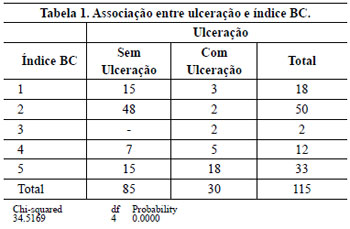
Não houve associação estatisticamente significante (p < 0,005) entre: regressão e índice BC, sexo e índice BC, tipo histológico e regressão, tipo histológico e sexo, índice mitótico e tipo histológico do tumor, invasão angiolinfática, margens livres ou comprometidas ou com presença ou ausência de regressão.
Todos os casos com invasão angiolinfática estiveram com índice BC = 5. Os casos com Breslow menor que 1, independente do Clark, não possuíram invasão angiolinfática. Houve forte associação estatisticamente significante (p < 0,005) entre invasão - índice BC (Tabela 2).
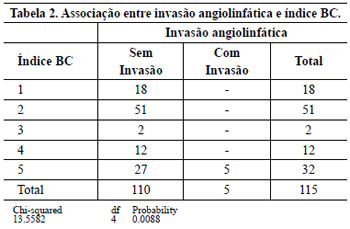
O índice BC 5 apresentou 64% dos casos com margens comprometidas e 64% dos casos com Breslow menor que 1, independente do Clark, tiveram margens livres, sendo essa associação estatisticamente significativa (p = 0,0012) (Tabela 3).

Em relação ao tipo histológico - índice BC (p = 0,0045), observou-se 71,8% dos casos de difusão superficial com Breslow menor que 1, independente do Clark, 71,4% dos casos de nodular índice BC = 5 e 85,7% com Breslow maior que 1, independente do Clark ,e observou-se 75% dos casos de lentiginoso acral com índice BC = 5 (Tabela 4).
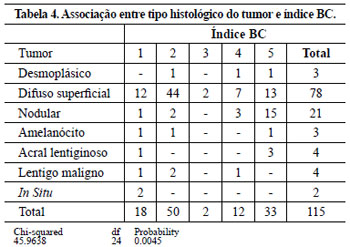
Na associação entre o tipo histológico - invasão angiolinfática, 80% dos tumores com invasão angiolinfática eram nodulares (p = 0,0063) (Tabela 5). Entretanto, a relação tipo histológico - margens foi de p = 0,0045, sendo que 47% dos tumores com margens comprometidas eram nodulares e 92,3% dos tumores tipo difusão superficial tiveram suas margens livres (Tabela 6). Também houve associação significativa entre tipo histológico - ulceração (p < 0,0001), sendo que 76% dos nodulares tinham úlceras e 11,7% dos casos com difusão superficial tinham úlceras (Tabela 7).
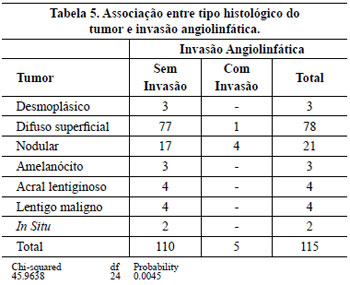
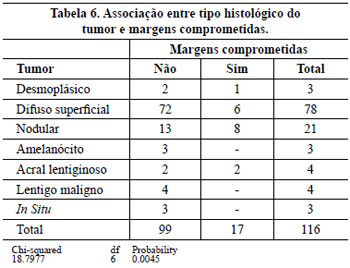
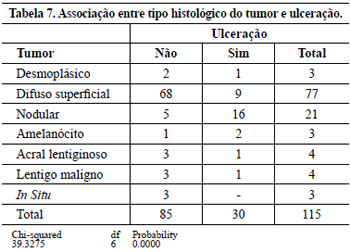
Em relação ao índice mitótico - índice BC, 41,7% do índice BC = 4 apresentavam-se com 6 ou mais mitoses e 51,5% do índice BC = 5 apresentavam-se com 6 ou mais mitoses (p < 0,0001) (Tabela 8). Também houve associação significativa entre Índice Mitótico - Ulceração (p < 0,0001), sendo que com menos de 5 mitoses 88,2% não ulceraram e com 6 ou mais mitoses ocorreram úlcera em 53,3% dos casos (Tabela 9).
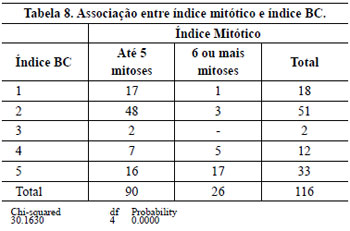
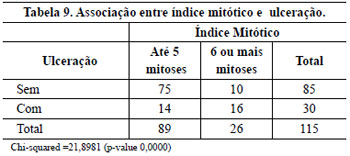
DISCUSSÃO
A incidência de melanoma cutâneo tem aumentado significativamente, tornando-se um problema de saúde pública14. Na Comunidade Européia já representa 1% e 1,8% de todos os tumores malignos do sexo masculino e feminino, respectivamente8. No Brasil, a incidência é de 3% a 4% das neoplasias malignas da pele1. No estudo realizado, todos os pacientes eram leucodérmicos, com 75% dos casos do sexo feminino.
Os principais riscos de se desenvolver melanoma maligno são a idade e a localização geográfica, seguido pelo sexo, exposição à radiação ultravioleta e o tempo fora de ambientes fechados15. Em geral, pode acometer ambos os sexos, tendo maior proporção de casos entre o gênero feminino3,7,16-19. Pode ocorrer em qualquer faixa etária, principalmente entre 30 e 80 anos3,4,7,16-21.
A sobrevida nos pacientes com melanoma maligno é dependente do estádio no diagnóstico4. O fator prognóstico local mais importante no melanoma maligno é a espessura do tumor6. O nível de Clark não foi considerado tão importante quanto a espessura de Breslow por alguns estudos, inclusive não sendo considerado um bom indicador prognóstico para o melanoma maligno6,22. Por outro lado, alguns estudos consideraram o nível de Clark um fator significante, especialmente em melanoma maligno de espessura fina (< 1mm)7,23,24. As duas classificações se mostraram fatores importantes para a presença de metástases linfonodais.
O nível de Clark (maior que III), o índice de Breslow, a presença de ulceração e idade do paciente maior que 60 anos se mostraram os fatores prognósticos independentes mais importantes associados com a presença de metástases em linfonodos25.
Em populações de origem européia, o tipo histológico predominante é o difusão superficial, ocorrendo de 44,7% a 68%. Em seguida, vem o nodular com 10% a 21%3,18,26. Em nossa casuística, 62,7% dos pacientes apresentavam-se com o tipo difuso superficial e 18,1%, com o tipo nodular. O tipo histológico do tumor pode ser considerado um preditor de sobrevida. O tipo nodular apresenta pior prognóstico, enquanto o tipo difuso superficial apresenta melhores índices de sobrevida3,18,26.
De uma forma geral, 13,9% a 25% dos casos de melanoma podem apresentar ulceração. Em análise multivariada, a presença de ulceração pode significar um indicador de mau prognóstico3,7,18,27, assim como um indicador de possível presença de metástases em linfonodos25.
O índice mitótico está entre os mais fortes indicadores prognósticos28,29. Segundo alguns autores, o índice mitótico fica atrás somente da espessura de Breslow como mais importante fator prognóstico24,30,31. Por outro lado, o índice mitótico, apesar de associado com a sobrevida, pode não ser um fator prognóstico independente, provavelmente por estar muito associado à espessura do tumor e à presença de ulceração32. Em nosso estudo, observou-se alto índice de mitoses por campo, isso demonstra a proporção de tumores mais agressivos em relação ao restante da amostra.
A espessura do tumor, a presença de ulceração e o índice mitótico normalmente têm uma relação estreita29,31,33, provavelmente por estarem intimamente relacionados com a agressividade do tumor24. Na maioria dos estudos, eles aparecem como os principais fatores prognósticos nos casos de melanoma maligno confinados ao local primário.
De maneira geral, muitos fatores prognósticos do melanoma maligno acabam se inter-relacionando, o que torna difícil demonstrar a importância de cada um isoladamente no prognóstico do paciente33.
Os cirurgiões plásticos são procurados por muitos pacientes para tratarem lesões de pele, principalmente por estarem localizadas em áreas expostas, em que às cicatrizes ficariam muito visíveis, ou pelo fato de possibilidade de malignização. A terapêutica eficaz depende de um diagnóstico precoce, associado a excisão da lesão com margens apropriadas34. A adequada ressecção da lesão primária é curativa nos casos onde não há presença de micrometástases14, sendo primordial que o tratamento tenha margens amplas e livres ao exame histológico14. É consenso que em lesões iguais ou menores que 1 mm de espessura, uma margem de 1 cm tem sido favorável para a cura destes pacientes13. As margens de ressecção utilizadas no estudo estão em consenso com a literatura, variando de 1 a 2 cm, de acordo com a espessura da lesão primária.
Protocolos cirúrgicos menos agressivos, como a biópsia do linfonodo sentinela, têm tomado lugar das condutas mais invasivas do passado35. Especificamente nos casos de melanoma, a biópsia do linfonodo sentinela e a terapia com interferon tiveram um impacto favorável no tratamento destes pacientes14. A biópsia do linfonodo sentinela nos traz um estadiamento da doença, com melhor planejamento terapêutico34. Alguns estudos na literatura médica mostram que a biópsia do linfonodo sentinela não traz benefícios para a sobrevida do paciente. Na realidade, as células metastáticas não se abrigam somente neste linfonodo, podendo ser um método falho para o diagnóstico em alguns casos de metástases em trânsito9.
O linfonodo sentinela representa o mais importante fator preditivo para os pacientes nos estágios iniciais de melanoma e é relevante no planejamento terapêutico nos estágios iniciais da doença10. Uma análise anatomopatológica cuidadosa é essencial para determinar a presença de melanoma em linfonodos sentinela, estes achados determinarão a indicação de uma linfadenectomia alargada. A ausência de doença metastática no linfonodo sentinela é fator preditivo de maior sobrevida e de futuro sem recorrência da enfermidade36.
O cirurgião plástico que pretende tratar estes tipo de doença deve possuir profundo conhecimento do comportamento histológico desta afecção, evitando os supertratamentos, prevenindo os subtratamentos, mantendo um excelente nível de relação médico paciente quanto às orientações em relação ao prognóstico e à morbidade da doença.
CONCLUSÃO
O estudo mostra que os fatores prognósticos de Breslow, Clark, ulceração e índice mitótico estão relacionados ao padrão de crescimento, sendo o índice de Breslow mais importante que o índice de Clark em relação à ulceração e, conseqüentemente, ao prognóstico. Existe alto risco do tipo nodular e baixo risco do tipo difusão superficial. A agressividade do lentiginoso acral é evidente. O índice mitótico é um importante fator de prognóstico. Os dados encontrados neste estudo foram testados estatisticamente e comprovaram os dados encontrados na literatura.
O tratamento cirúrgico da lesão primária ou cicatricial com margens adequadas, associado a um resultado negativo para melanoma da biópsia do linfonodo sentinela apresenta baixa morbidade operatória, principalmente dos pacientes no estágio I da doença.
REFERÊNCIAS
1. Silva CSC, Fernandes NC. Tumores cutâneos. In: Franco T, editor. Princípios de cirurgia plástica. São Paulo:Atheneu;2002. p.191-6.
2. Demierre MF. Epidemiology and prevention of cutaneous melanoma. Curr Treat Options Oncol. 2006;7(3):181-6.
3. Avilés JA, Lázaro P, Lecona M. Epidemiology and survival of cutaneous melanoma in Spain: a report of 552 cases (1994-2003). Rev Clin Esp. 2006;206(7):319-25.
4. Berwick M, Wiggins C. The current epidemiology of cutaneous malignant melanoma. Front Biosci. 2006;11:1244-54.
5. AJCC. American Joint Committee Cancer Staging Manual. 6th ed. New York:Springer-Verlag;2002.
6. Barnhill RL, Fine JA, Roush GC, Berwick M. Predicting five-year outcome for patients with cutaneous melanoma in a population-based study. Cancer. 1996;78(3):427-32.
7. Marghoob AA, Koenig K, Bittencourt FV, Kopf AW, Bart RS. Breslow thickness and Clark level in melanoma: support for including level in pathology reports and in American Joint Committee on Cancer Staging. Cancer. 2000;88(3):589-95.
8. De Braud F, Khayat D, Kroon BB, Valdagni R, Bruzzi P, Cascinelli N. Malignant melanoma. Crit Rev Oncol Hematol. 2003;47(1):35-63.
9. Medalie NS, Ackerman AB. Sentinel lymph node biopsy has no benefit for patients with primary cutaneous melanoma metastatic to a lymph node: an assertion based on comprehensive, critical analysis: part I. Am J Dermatopathol. 2003;25(5):399-417.
10. Aguiar LFS, Pfuetzenreiter EG, Ribeiro LAN, Martignago E. Análise histopatológica do melanoma em cabeça e pescoço. Rev Bras Cir Cabeça Pescoço. 2007;36(2):104-7.
11. Mariani G, Erba P, Manca G, Villa G, Gipponi M, Boni G, et al. Radioguided sentinel lymph node biopsy in patients with malignant cutaneous melanoma: the nuclear medicine contribution. J Surg Oncol. 2004;85(3):141-51.
12. Rousseau DL Jr, Gershenwald JE. The new staging system for cutaneous melanoma in the era of lymphatic mapping. Semin Oncol. 2004;31(3):415-25.
13. Thompsom JF, Scolyer RA, Kefford RF. Cutaneous melanoma. Lancet. 2005;365(9460):687-701.
14. Wagner JD, Bergman D. Primary cutaneous melanoma: surgical management and other treatment options. Curr Trat Options Oncol. 2003;4(3):177-85.
15. Fears TR, Guerry D 4th, Pfeiffer RM, Sagebiel RW, Elder DE, Halpern A, et al. Identifying individuals at high risk of melanoma: a practical predictor of absolute risk. J Clin Oncol. 2006;24(22):3590-6.
16. Criado PR, Vasconcellos C, Sittart JA, Valente NY, Moura BP, Barbosa GL, et al. Melanoma maligno cutâneo primário: estudo retrospectivo de 1963 a 1997 no Hospital do Servidor Público Estadual de São Paulo. Rev Assoc Med Bras. 1999;45(2):157-62.
17. Ishihara K, Saida T, Yamamoto A; Japanese Skin Cancer Society Prognosis and Statistical Investigation Committee. Updated statistical data for malignant melanoma in Japan. Int J Clin Oncol. 2001;6(3):109-16.
18. Lindholm C, Andersson R, Dufmats M, Hansson J, Ingvar C, Möller T, et al; Swedish Melanoma Study Group. Invasive cutaneous malignant melanoma in Sweden, 1990-1999. A prospective, population-based study of survival and prognostic factors. Cancer. 2004;101(9):2067-78.
19. Kalady MF, White RR, Johnson JL, Tyler DS, Seigler HF. Thin melanomas: predictive lethal characteristics from a 30-year clinical experience. Ann Surg. 2003;238(4):528-35.
20. Hussein MR, Elsers DA, Fadel SA, Omar AE. Clinicopathological features of melanocytic skin lesions in Egypt. Eur J Cancer Prev. 2006;15(1):64-8.
21. Bevona C, Goggins W, Quinn T, Fullerton J, Tsao H. Cutaneous melanomas associated with nevi. Arch Dermatol. 2003;139(12):1620-4.
22. Owen SA, Sanders LL, Edwards LJ, Seigler HF, Tyler DS, Grichnik JM. Identification of higher risk thin melanomas should be based on Breslow depth not Clark level IV. Cancer. 2001;91(5):983-91.
23. Balch CM, Buzaid AC, Soong SJ, Atkins MB, Cascinelli N, Coit DG, et al. Final version of the American Joint Committee on Cancer staging system for cutaneous melanoma. J Clin Oncol. 2001;19(16):3635-48.
24. Elder DE, Gimotty PA, Guerry D. Cutaneous melanoma: estimating survival and recurrence risk based on histopathologic features. Dermatol Ther. 2005;18(5):369-85.
25. McMasters KM, Wong SL, Edwards MJ, Ross MI, Chao C, Noyes RD, et al. Factors that predict the presence of sentinel lymph node metastasis in patients with melanoma. Surgery. 2001;130(2):151-6.
26. Luke CG, Coventry BJ, Foster-Smith EJ, Roder DM. A critical analysis of reasons for improved survival from invasive cutaneous melanoma. Cancer Causes Control. 2003;14(9):871-8.
27. Zettersten E, Shaikh L, Ramirez R, Kashani-Sabet M. Prognostic factors in primary cutaneous melanoma. Surg Clin North Am. 2003;83(1):61-75.
28. Nagore E, Oliver V, Botella-Estrada R, Moreno-Picot S, Insa A, Fortea JM. Prognostic factors in localized invasive cutaneous melanoma: high value of mitotic rate, vascular invasion and microscopic satellitosis. Melanoma Res. 2005;15(3):169-77.
29. Francken AB, Shaw HM, Thompson JF, Soong SJ, Accortt NA, Azzola MF, et al. The prognostic importance of tumor mitotic rate confirmed in 1317 patients with primary cutaneous melanoma and long follow-up. Ann Surg Oncol. 2004;11(4):426-33.
30. Barnhill RL, Katzen J, Spatz A, Fine J, Berwick M. The importance of mitotic rate as a prognostic factor for localized cutaneous melanoma. J Cutan Pathol. 2005;32(4):268-73.
31. Azzola MF, Shaw HM, Thompson JF, Soong SJ, Scolyer RA, Watson GF, et al. Tumor mitotic rate is a more powerful prognostic indicator than ulceration in patients with primary cutaneous melanoma: an analysis of 3661 patients from a single center. Cancer. 2003;97(6):1488-98.
32. Attis MG, Vollmer RT. Mitotic rate in melanoma: a reexamination. Am J Clin Pathol. 2007;127(3):380-4.
33. Homsi J, Kashani-Sabet M, Messina JL, Daud A. Cutaneous melanoma: prognostic factors. Cancer Control. 2005;12(4):223-9.
34. Thompsom JF, Scolyer RA, Kefford RF. Cutaneous melanoma. Lancet. 2005;365(9460):687-701.
35. Zalaudek I, Ferrara G, Argenziano G, Ruocco V, Soyer HP. Diagnosis and treatment of cutaneous melanoma: a practical guide. Skinmed. 2003;2(1):20-31.
36. Cochran AJ, Roberts A, Wen DR, Huang RR, Itakura E, Luo F, et al. Update on lymphatic mapping and sentinel node biopsy in the management of patients with melanocytic tumors. Pathology. 2004;36(5):478-84.
I. Residente de cirurgia plástica do Instituto Ivo Pitanguy.
II. Membro Titular da Sociedade Brasileira de Cirurgia Plástica; Professor Assistente do Instituto Ivo Pitanguy.
Trabalho realizado no Hospital Santa Isabel, Blumenau, SC e Instituto Ivo Pitanguy, Rio de Janeiro, RJ.
Este artigo foi submetido pelo SGP (Sistema de Gestão de Publicações) da RBCP.
Artigo recebido: 17/2/2009
Artigo aceito: 30/4/2009


 Read in Portuguese
Read in Portuguese
 Read in English
Read in English
 PDF PT
PDF PT
 Print
Print
 Send this article by email
Send this article by email
 How to Cite
How to Cite
 Mendeley
Mendeley
 Pocket
Pocket
 Twitter
Twitter